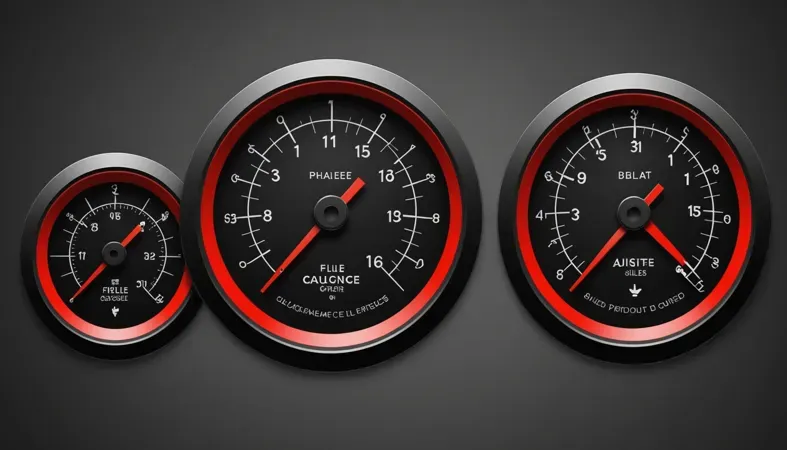How to Use a Fillet Weld Gauge? Understanding, Steps, and Applications
Published on: May 1, 2025 | Last modified: March 4, 2025
By: Joe Carter
A fillet weld gauge is a handy tool that measures the size of fillet welds. It helps ensure your welds fit the required standards.
So, how to use a fillet weld gauge? It’s crucial because accurate measurements guarantee strong, reliable welds. From my experience, using this gauge not only saves time but also prevents costly mistakes.
In this article, we’ll cover what a fillet weld gauge is, types of fillet weld gauges, necessary prerequisites, steps to using one, precautions, applications, factors affecting usage, common issues, aftercare, inspection, advanced tips, benefits, typical applications, and alternatives. You’ll learn how to read a fillet weld gauge effectively and improve your welding skills!
Contents
- How to Use A Fillet Weld Gauge?
- What is a Fillet Weld Gauge?
- Types Of Fillet Weld Gauges
- Prerequisites
- Steps to Using a Fillet Weld Gauge
- Precautions
- Types Of Fillet Weld Gauge Applications
- Factors Affecting Fillet Weld Gauge Usage
- Common Issues
- Aftercare, Inspection, and Advanced Tips for Using a Fillet Weld Gauge
- Understanding Fillet Weld Gauge Calibration
- Key Benefits Of Using a Fillet Weld Gauge
- Typical Applications Of Fillet Weld Gauges
- Other Options for Measuring Weld Size
- Frequently Asked Questions (FAQs)
- Conclusion
- References
How to Use A Fillet Weld Gauge?
A fillet weld gauge is a tool for measuring weld sizes. To use a fillet weld gauge, align it with the weld; check sizes in millimeters (Mm) or inches (In). It’s straightforward, suitable for fabrication or repair work.
What is a Fillet Weld Gauge?
A fillet weld gauge is an essential tool for welders. It measures the size of a fillet weld to ensure it meets specific standards. This gauge typically ranges from 1/8 inch (3.175 Mm) to 1 inch (25.4 Mm) in leg length. It usually features several angles: 30°, 45°, and 90°, allowing for versatile measurements.
How do you use a fillet weld gauge? Place the gauge against the weld and check for fit. It’s crucial to align the angles precisely with the weld’s base. This alignment confirms that your weld meets quality specifications.
I used it at work mainly to inspect robust structural welds on steel beams. Accurately reading a fillet weld gauge made a significant difference on job sites. Using this gauge helped me catch defects early, saving money and time on rework, often amounting to thousands of dollars, especially on larger projects.
Types Of Fillet Weld Gauges
What are the types of fillet weld gauges?
-
Fixed Fillet Weld Gauges
Fixed fillet weld gauges have set measurements. To use a fixed gauge, align it with the weld and check for fit. Hold the fixed gauge against the weld; if it fits snugly, the weld meets specifications.
-
Adjustable Fillet Weld Gauges
Adjustable fillet weld gauges allow for immediate measurement changes. To use an adjustable gauge, twist the dial to your desired measurement and position it on the weld. Adjust until the pointer reaches your target—that’s your weld size!
-
Digital Fillet Weld Gauges
Digital fillet weld gauges display measurements electronically. To operate a digital gauge, place it against the weld and turn it on. The screen shows your measurement instantly, making it quick and accurate.
-
Mechanical Fillet Weld Gauges
Mechanical fillet weld gauges use a sliding scale for measurement. To use this type, slide the gauge along the weld until it stops. The markings on the gauge show you the weld size in millimeters (Mm) or inches (In).
-
Calibrated Fillet Weld Gauges
Calibrated fillet weld gauges are precision tools designed for accurate readings. To use a calibrated gauge, place it against the weld and read it. Ensure it’s properly calibrated for best results—this guarantees accuracy!
So far we covered the various kinds of fillet weld gauges. Next, let’s look at the necessary prerequisites.

Prerequisites
What do you need to know before you start?
- Fillet Weld Gauge: You need a specific gauge, such as the 5-48 Finest Fit Fillet Weld Gauge. It’s essential for accurate weld size measurements.
- Calipers: A pair of digital calipers, like the Mitutoyo 500-196-30, is necessary for measuring material thickness. This ensures you achieve the correct weld size.
- Welding Markers: Use industrial welding markers, such as the Hobart 770568, to mark your work area. Clear markings aid in positioning and executing accurate measurements.
- Steel Rule: A 300mm (12-inch) steel rule, like the Starrett C1012, is required for additional length measurements. It helps with proper setup for welding projects.
That covers the necessary prerequisites. Let’s now take a look at the steps for using a fillet weld gauge.
Steps to Using a Fillet Weld Gauge
Now, we’ll cover the steps for using a fillet weld gauge to measure welds accurately.
-
Position the Gauge
First, place the fillet weld gauge on the weld, ensuring it aligns with the toe and root. The gauge has two legs; one should sit flat against the base metal, while the other measures the weld height. Ensure the surface is clean for accurate measurements. If you’re using a Bridge Cam gauge, adjust it according to the manufacturer’s specifications before measuring. The
importance of electrode classification can heavily influence the quality of welding jobs.A properly positioned gauge ensures reliable results. Take care with long welds and varying heights; misalignment can lead to incorrect readings. A little patience here will save time later.
-
Read the Measurements
Next, look at the measuring scale on the gauge. A standard fillet weld gauge shows both imperial (Inches) and metric (Millimeters) readings. Note the height (Leg Length) and throat thickness of the weld. If the gauge has multiple scales, choose the one that fits your project needs.
Reading the gauge should be straightforward. Focus on the correct numbers; discrepancies can lead to design flaws. Always use the right scale for consistency.
-
Document Your Findings
Once you’ve read the measurements, record them. Documenting details like leg lengths and throat thickness can be crucial for future inspections or welding processes. Accuracy in documentation prevents potential issues. A well-organized log helps track progress and quality.
This step is invaluable. Detailed records protect against misunderstandings later. Keep a digital or manual log—it pays off!
-
Calculate Acceptance Criteria
After documenting your findings, compare your measurements against the acceptance criteria for your project. Check the specifications, which dictate the minimum and maximum allowable sizes for welds. If your measurements don’t meet these standards, plan corrective actions promptly. Keeping these parameters in mind ensures structural integrity.
Don’t skip this step; it’s critical. If you’re ever unsure, refer back to industry or project standards. They’re there for a reason and often save you from costly repairs.
You should now have a good understanding of how to use a fillet weld gauge effectively. In the next part, we’ll discuss safety measures.
Precautions
Let’s cover essential safety measures for using a fillet weld gauge.
- Wear Protective Gear: Always use safety glasses to protect your eyes. Consider brands like 3M for reliable protection.
- Check Gauge Calibration: Ensure your fillet weld gauge is adjusted correctly. Check it monthly for accurate results.
- Avoid Stressing the Gauge: Don’t apply excessive force on the gauge. More than 5 kg (11 Lbs) can negatively impact accuracy.
- Keep Workspace Clean: A tidy area prevents accidents. Organize with cobweb-free zones for optimal workflow.
Staying safe makes welding enjoyable for everyone!
You should now have a good understanding of safety measures and best practices. In the next part, we’ll discuss applications of fillet weld gauges.
Types Of Fillet Weld Gauge Applications
Let’s discuss the types of fillet weld gauge applications: measuring weld quality, verifying weld sizes, assessing joint designs, and ensuring compliance with standards.
-
Measuring Weld Quality
A fillet weld gauge measures weld quality by checking bead size and penetration. The gauge has jaws that help quantify the weld leg sizes accurately, typically requiring measurements in millimeters (Mm) or inches. A well-welded joint should have leg lengths equal to or nearly equal to specifications, usually a minimum of 3mm (1/8 Inch).
-
Verifying Weld Sizes
When verifying weld sizes, the fillet weld gauge is your best ally. Position the gauge against the weld to confirm its size matches the blueprint. Consistent checks can prevent costly reworks, especially if sizes deviate by just 1mm (0.04 Inch). Standard fillet sizes typically range from 5mm (3/16 Inch) to 10mm (3/8 Inch).
-
Assessing Joint Designs
The fillet weld gauge is crucial for assessing joint designs. Use it to ensure the weld angle conforms to design specifications. Some designs require a 45-degree angle, while others need different angles. Proper gauge use helps achieve these angles for better load distribution.
-
Ensuring Compliance With Standards
Compliance with welding standards is vital, and a fillet weld gauge assists in this area. Check the weld against industry standards like AWS D1.1 to ensure your welds are structurally sound and meet necessary safety guidelines. Compliance can save you from legal issues or project delays.
-
Evaluating Weld Integrity
To evaluate weld integrity, the fillet weld gauge is essential. It helps identify issues like undercutting or overlap by measuring joint sizes and shapes. Consistent gauge use can catch defects early, preventing later failures. Always compare results against established parameters; it’s worth it!

Factors Affecting Fillet Weld Gauge Usage
What factors should you consider for effective fillet weld gauge application?
-
Weld Material Type
Different materials, like steel and aluminum, respond uniquely under welding heat. For example, steel has a melting point of approximately 1,540°C (2,800°F), while aluminum melts at 660°C (1,220°F). This affects gauge readings since material properties influence joint strength and penetration. Precise understanding of these details enhances one’s ability to interpret how to read welding blueprints.
-
Weld Joint Configuration
The shape and arrangement of joints matter. A T-joint may require a deeper fill than a lap joint, affecting measurements. Understanding these configurations dictates how the fillet weld gauge reads and which measurements are crucial for structural integrity.
-
Welding Process Used
The welding technique can change gauge readings. MIG, TIG, and Stick welding create different bead shapes. Knowing which process you’re using allows for accurate adjustments and readings with the fillet weld gauge.
-
Environmental Conditions
Wind, humidity, and temperature can impact your welding results. High winds can destabilize shielding gas, and extreme temperatures can affect metal behavior. Monitoring these factors ensures accurate gauge readings. Proper visibility is crucial in achieving optimal weld quality, so it is important to know how to see better when welding.
-
Operator Skill Level
Your experience significantly impacts gauge interpretation. Novice welders may struggle with reading gauges accurately, while experienced welders easily catch subtleties. Continuous training improves your ability to use the fillet weld gauge effectively.
Common Issues
Let’s look at specific technical problems with the fillet weld gauge.
-
Inaccurate Measurements
The fillet weld gauge can give inaccurate readings due to dirt or debris. To fix this, ensure the gauge is clean and properly aligned before measuring.
-
Gauge Misalignment
If the fillet weld gauge isn’t aligned correctly, you’ll get false measurements. Check alignment by ensuring the gauge contacts the weld’s edges.
-
Worn Gauges
If the fillet weld gauge is worn or damaged, you can’t trust its readings. Inspect it regularly and replace worn parts promptly to maintain measurement accuracy.
-
Improper Use Of Gauges
Using the fillet weld gauge incorrectly can lead to serious errors. Always refer to the manual for proper use and take multiple readings to confirm accuracy.
-
Calibration Errors
Calibrate the fillet weld gauge regularly. If you notice inconsistent readings, it’s time to recalibrate. Follow certified practices for optimal results.
Aftercare, Inspection, and Advanced Tips for Using a Fillet Weld Gauge
Here’s essential guidance on aftercare, specific inspection, and expert tips for your fillet weld gauge.
Aftercare Tips
After using your fillet weld gauge, clean it with a lint-free cloth to remove debris. Store it in its case to avoid nicks or scratches. Inspect the gauge for noticeable wear or damage to maintain accuracy and extend its lifespan.
Inspection Guidelines
Check the calibration mark after each use to ensure accuracy. Use a feeler gauge, like the Starrett 209, to inspect for wear every 500 uses. Look for deformations or discrepancies in measurements; these can affect quality over time.
Expert Tips
Calibrate your fillet weld gauge at least every six months for precision. If you’re focusing on angles, use a digital gauge that measures in both degrees and percentages for flexibility. Consistent readings can save you up to 15% on material costs when welding thicker metals over time.
Understanding Fillet Weld Gauge Calibration
Calibration is essential for accurate measurements with a fillet weld gauge. Let’s break down how to effectively calibrate your gauge.
| Calibration Step | Description | Frequency |
|---|---|---|
| Visual Inspection | Check for any physical damage or wear that could affect measurements. | Before every use |
| Zero Adjustment | Place the gauge on a certified flat surface to ensure it reads zero when closed. | Monthly |
| Comparison Check | Use a standard depth gauge or block of known thickness to compare readings. | Every 500 uses |
| Recording Results | Document calibration results and any discrepancies for future reference. | With every calibration check |
| Professional Calibration | For precise tools, send them to a professional for calibration using industry standards. | Yearly |
Key Benefits Of Using a Fillet Weld Gauge
The main benefit of using a fillet weld gauge is precision. I use it at work to ensure my welds meet the correct size and strength standards.
Additionally, it helps with consistency, speed, and ease of use, making welding tasks smoother. It also enhances quality control, minimizes errors, and saves time during inspections.
Typical Applications Of Fillet Weld Gauges
Fillet weld gauges are commonly used for quality control in welding projects. They have several unique applications, including:
- Bridge Construction: Checks fillet welds on structural beams to ensure strength and safety under heavy loads. It’s popular in civil engineering.
- Pipeline Fabrication: Verifies weld size on joints to prevent leaks and maintain integrity. It’s commonly used in the oil and gas industry.
- Shipbuilding: Assesses welds in hull structures to guarantee durability against harsh marine conditions. It’s widely utilized by shipyards.
- Aerospace Manufacturing: Measures weld quality in aircraft components to ensure safety and compliance with strict regulations. It’s increasingly popular in the aerospace sector.
Other Options for Measuring Weld Size
There are alternatives to achieve the same results when you’re checking weld sizes. You might consider tools like the Bridge Cam gauge or the Weld Fillet Gauge set. From my unique perspective, I’ve noticed that some pros prefer these options for their speed and ease of use, especially in tighter spots where a fillet weld gauge isn’t as practical.
Another handy method is using digital weld gauges, which can give you precise measurements quickly. They often come with features that let you store and recall data, making them great for projects that require documentation. So, whether you’re in a workshop or on-site, these options can save you time and ensure accuracy.
Frequently Asked Questions (FAQs)
Now let us look at some common questions I typically get asked.
How Do You Select the Correct Fillet Weld Gauge for the Job?
To select the correct fillet weld gauge for the job, consider the weld size and the materials involved. Use a gauge that matches the dimensions you need, typically ranging from 1/16 inch (1.6 Mm) to 1 inch (25.4 Mm). This ensures accuracy and compliance with welding standards.
How to Measure the Size Of a Fillet Weld?
You measure the size of a fillet weld by using a fillet weld gauge, which has specific notches for different sizes. This gauge allows you to check the leg length, which should conform to codes like AWS D1.1, ensuring a weld’s integrity and strength.
What is the Rule Of Thumb for Fillet Weld Thickness?
The rule of thumb for fillet weld thickness is to make it equal to the thickness of the thinner base metal. This creates a strong bond without excess material. If you’re using standard metals, this helps achieve a solid joint efficiently.
Can You Use a Fillet Weld on Structural Steel?
Yes, you can use a fillet weld on structural steel. Fillet welds are common in steel construction due to their strength and versatility. They can handle shear forces well, making them ideal for joining structural components in buildings and bridges.
What Materials Can Be Welded Using a Fillet Weld Gauge?
You can use a fillet weld gauge on materials like steel, aluminum, and stainless steel. Each material may require specific welding techniques and filler materials, but the gauge helps ensure your welds are accurate for any base metal.
Conclusion
We are almost done. We covered what a fillet weld gauge is, different types, prerequisites for use, steps to effectively use the gauge, and precautions to take. We also discussed applications, factors affecting usage, common issues, and aftercare tips.
Happy you’ve made it this far. To use a fillet weld gauge, align the gauge with the right angle of the weld—typically at a 45-degree angle. Measure the weld size, referencing the appropriate numbers, and confirm it meets specifications for quantity and quality. You now know how to use a fillet weld gauge effectively.
For further insights into welding techniques and information, feel free to explore What is Welding.
References
- American Welding Society. (2015). AWS D1.1/D1.1M: Structural Welding Code – Steel. Miami, FL: AWS.
- International Institute of Welding (IIW): https://www.iiwelding.org
- Kou, S. (2003). Welding Metallurgy (2nd ed.). Hoboken, NJ: Wiley.
- American Welding Society. (2020). AWS C5.6: Recommended Practices for Gas Metal Arc Welding. Miami, FL: AWS.
Joe Carter is a retired welding professional with over 40 years of hands-on experience in the industry, spanning ship repair, structural welding, and even underwater projects. Joe is a master of MIG, TIG, and Stick welding. Passionate about mentoring the next generation of welders, Joe now shares his decades of expertise and practical insights to help others build rewarding careers in welding.
American Welding Society, Fillet Weld Gauge, Measuring Welds, Quality Control In Welding, Structural Integrity, Welding, Welding Safety, Welding Standards, Welding Techniques, Welding Tools







